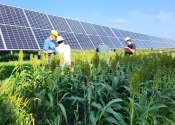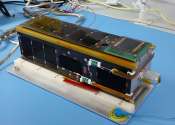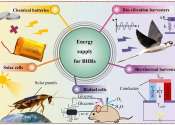The Solar System[a] consists of the Sun and those celestial objects bound to it by gravity, all of which formed from the collapse of a giant molecular cloud approximately 4.6 billion years ago. The Sun's retinue of objects circle it in a nearly flat disc called the ecliptic plane, most of the mass of which is contained within eight relatively solitary planets whose orbits are almost circular. The four smaller inner planets; Mercury, Venus, Earth and Mars, also called the terrestrial planets, are primarily composed of rock and metal. The four outer planets, Jupiter, Saturn, Uranus and Neptune, also called the gas giants, are composed largely of hydrogen and helium and are far more massive than the terrestrials.
The Solar System is also home to two main belts of small bodies. The asteroid belt, which lies between Mars and Jupiter, is similar to the terrestrial planets as it is composed mainly of rock and metal. The Kuiper belt (and its subpopulation, the scattered disc), which lies beyond Neptune's orbit, is composed mostly of ices such as water, ammonia and methane. Within these belts, five individual objects, Ceres, Pluto, Haumea, Makemake and Eris, are recognised to be large enough to have been rounded by their own gravity, and are thus termed dwarf planets. The hypothetical Oort cloud, which acts as the source for long-period comets, may also exist at a distance roughly a thousand times beyond these regions.
Within the Solar System, various populations of small bodies, such as comets, centaurs and interplanetary dust, freely travel between these regions, while the solar wind, a flow of plasma from the Sun, creates a bubble in the interstellar medium known as the heliosphere, which extends out to the edge of the scattered disc.
Six of the planets and three of the dwarf planets are orbited by natural satellites, usually termed "moons" after Earth's Moon. Each of the outer planets is encircled by planetary rings of dust and other particles.









